The BLT Built Design Awards announce the opening of submissions for the 2026 edition, inviting architects, interior designers, landscape architects, construction innovators, and emerging talents to present their most accomplished and thoughtful work. As one of the world’s most internationally recognised programs dedicated to the built environment, the BLT Built Design Awards celebrate projects that demonstrate design excellence, technical mastery, cultural relevance, and a meaningful contribution to shaping our cities, spaces, and communities.
The launch follows the unforgettable 2025 and 2024 Winners’ Celebration in Basel, Switzerland, where the global design community gathered to honour outstanding work from more than 60 countries. The evening made clear how deeply the Awards resonate across continents, bringing together established firms, independent creators, academics, developers and young designers who share the same dedication to responsible and intelligent design.
Reflecting on the success of the past season, co-founder Astrid Hébert shared: “The ceremony in Switzerland felt incredibly special. Seeing renowned practices and first-time student winners stand proudly on the same stage was truly moving. The BLT Built Design Awards have become a place where diverse perspectives meet: designers from different cultures, climates, and disciplines all presenting work rooted in meaning and purpose. With the 2026 edition now open, we’re excited to welcome another year of ideas and projects that enrich the global conversation about the built environment.“
Submissions to the BLT Built Design Awards 2026 will be reviewed by an extensive panel of respected professionals whose expertise spans architecture, interior design, landscape architecture, construction, academia and industry innovation. The current jury includes Samantha Lassoudry, Founder and Chief Designer at Lassoudry Architects; Christian Brendelberger of Dietziker Partner Baumanagement AG; Anastasia Ignatova, Urban Planning and Design Expert; Andreas Rupf, Head of ETH RAUM and Founder of SPEKTRUM GmbH; Muhammad Habsah of U+A, part of the 10N Collective; Mona Vijaykumar, Associate Urban Designer at Perkins&Will; Cas Esbach, Founder of KANS and Professor at SCAD; Tran Ngoc Danh, Vice President of the Vietnam Design Association (VDAS) and Founder of VMARK Vietnam Design Award; Christina Chen-Chiao Kuo, Founder and Creative Director of Kuuo Living Limited; Omar Zhan, Co-founder and COO of Surfaice and the “Construction Voices” AI digest; Amir Idiatulin, Founder and CEO of IND; Zhou Yi, Chief Designer at Dayi Design; and Rudi Stouffs, Dean’s Chair Associate Professor and Assistant Dean (Research) at the College of Design and Engineering, National University of Singapore.
They are joined by Osaru Alile of CC Interiors Studio; Pal Pang, Chief Creative Officer at Another Design International; Juliet Kavishe, Executive Board Member of the Pan Afrikan Design Institute; Sandra Baggerman of Trahan Architects; Des Laubscher, Co-Founder and CEO of the Greenside Design Center, College of Design and Hannah Churchill, Founder and Design Director at hcreates interior design, and more big names in the industry. Together, they ensure a rigorous, insightful and globally informed evaluation process.
The program’s scope is reflected in its previous winners. In recent editions, Zaha Hadid Architects were honoured for the King Abdullah Financial District Metro Station in Riyadh; Sanjay Puri Architects received recognition for the Aatma Manthan Museum in Rajasthan; LANDPROCESS, led by Kotchakorn Voraakhom, transformed the Thailand Government Complex into a regenerative landscape; VINE, created by the University of Ulsan and Studio Kwan, introduced a new photovoltaic façade system; and emerging designers such as Lotte Scheder-Bieschin of ETH Zurich and Lisa Van Staden presented forward-thinking work that captivated both jurors and the global audience.
Winners of the BLT Built Design Awards receive significant international exposure. Their work is featured on the official BLT website, published in the annual BLT Awards Book of Design, shared across global press and partner networks, and celebrated at the next awards ceremony. This gathering continues to grow in scale, prestige and visibility. For many firms and emerging designers, the Awards have become a platform that elevates their work, expands their audience and opens new professional pathways.
With submissions now open, entrants are encouraged to take advantage of the 10% Early Bird discount available until March 31st, 2026. The BLT Built Design Awards 2026 welcome completed projects, conceptual work, prototypes and student submissions from every region of the world. Whether exploring new construction methods, redefining interior experience, shaping public landscapes or presenting thoughtful architectural strategies, the Awards seek projects that demonstrate clarity, intention and a meaningful contribution to the built environment.
Submissions for the BLT Built Design Awards 2026 are now open at bltawards.com.
A record-setting ceremony that brought together world-renowned studios, award-winning architects and a new generation of emerging designers for a night dedicated to creativity, collaboration and the future of design inside one of Basel’s most iconic cultural spaces.
On Friday, November 21st, 2025, Basel became the centre of the international design community as the BLT Built Design Awards and the SIT Furniture Design Award came together for their largest celebration to date. Two hundred guests from more than thirty countries, from China, Japan, Thailand, South Korea and Vietnam to the United States, Canada, Costa Rica, Argentina, South Africa and New Zealand, gathered inside the spectacular Elisabethenkirche, the 19th-century neo-Gothic landmark now transformed into one of Switzerland’s most striking contemporary cultural venues.
The decision to host the ceremony in the Elisabethenkirche underscored the awards’ shared values, honouring innovation, craftsmanship and adaptive reuse design at a moment when architecture and furniture design continue to respond creatively to the challenges of the built environment.
The evening brought together the winners of the 2024 and 2025 BLT Built Design Awards and the SIT Furniture Design Award, presenting both trophies and certificates on stage, accompanied by a seated gala dinner. Designers, architects, product innovators, academics, students, media partners and jury members connected throughout the evening, turning the neo-Gothic space into a lively international meeting point.
The ceremony was led by the 3C Group co-founders, Astrid Hébert and Hossein Farmani, who guided an extensive programme featuring some of the world’s most notable firms and emerging talents. Jury members joined them on stage to present the top-level trophies, including Pal Pang, London-based interior architect and artist and Chief Creative Officer of Another Design International; Dr. Anna Grichting Solder, Swiss architect, urbanist and musician with a Doctor of Design in Urbanism from Harvard; Andreas Rupf, Head of ETH RAUM at ETH Zürich and founder of SPEKTRUM GmbH, specialising in strategic spatial planning; Samantha Lassoudry, Founder & Chief Designer of Lassoudry Architects in Basel with a “custom-made couture” approach; Amir Idiatulin, Founder & CEO of IND (Russia/Global) and leader in architecture and urban strategy; Christian Brendelberger, Partner at Dietziker Partner Baumanagement AG and Head of Cost Planning on large-scale Swiss projects; and Alain Gilles, Brussels-based furniture and product designer, founder of The Studio and acclaimed internationally for his award-winning design work.
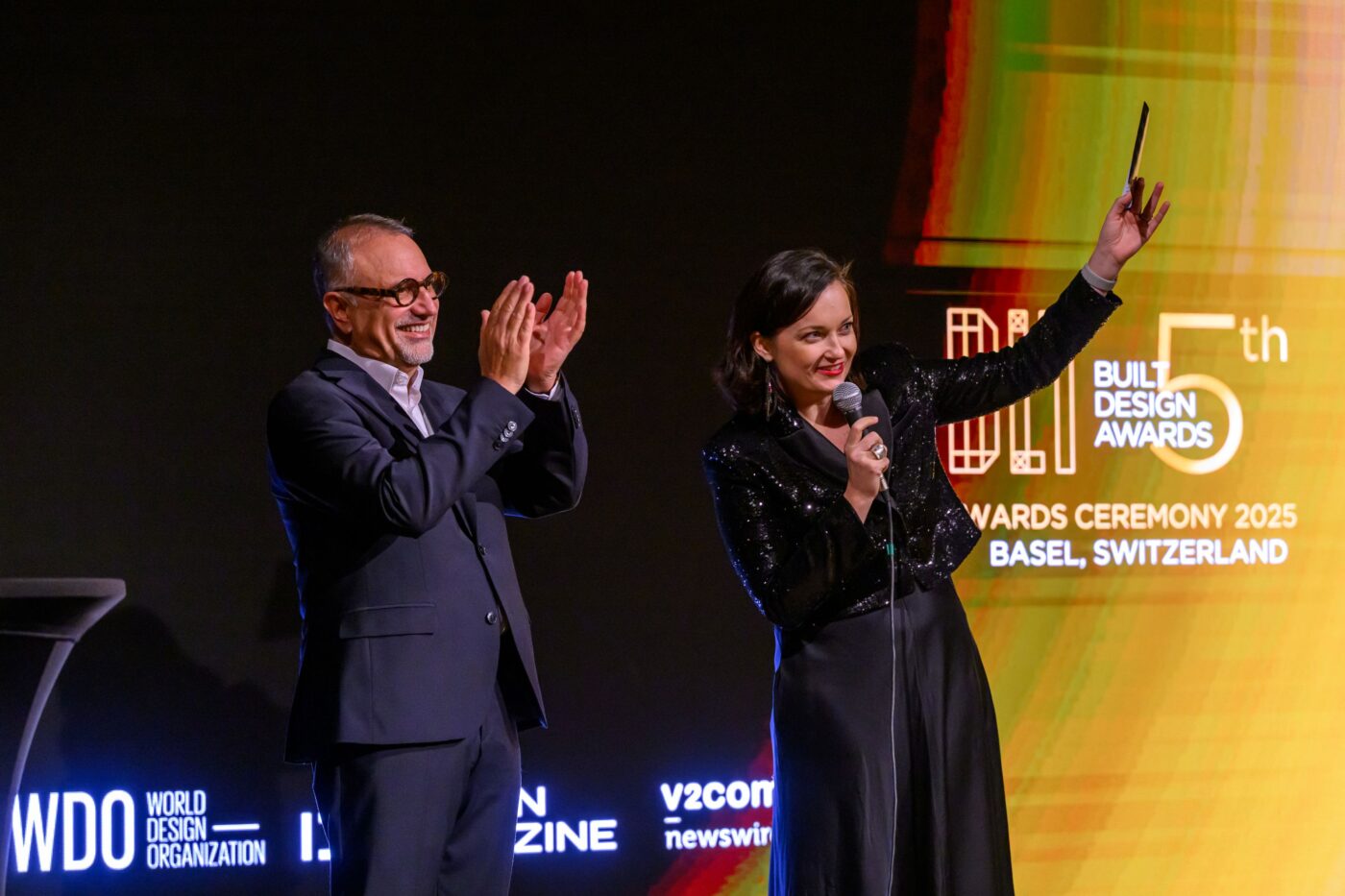
This year’s BLT Built Design Awards program featured major winners such as Kebony, The Volks Design & Research Consulting Ltd., Arsomsilp Community and Environmental Architect, The Backcountry Hut Company, Sanjay Puri Architects, Landprocess, Studio Kwan at the University of Ulsan, ETH Zürich’s Block Research Group and the Bartlett School of Architecture at UCL, with an extensive list of international studios on stage including Ritchie Studio, Rossetti+Wyss Architekten, AKB Architects, Morph, AUN Design Studio, BORD Architectural Studio, Dome+Partners, Ho Khue Architects, NG Architects, PT Golden Tree Architects, GAUS Architekten, Dost Architektur, Studio RAMO, Steidle Architekten, Sakai Architects, Kris Lin International Design, Acebal Canney Arquitectos & Asociados, Jaime Guzman Creative Group, Sound & Vision, Shinagawa Arquitetura, Maxim Kashin Architects, BUILT Inc., Atwater Inc Studio, Churina Design, AIYA Bureau, Carlo Schembri with Andbold, Minimal Studio, Urbanjobs and DBA.
Students from fifteen universities were welcomed on stage throughout the evening, including Cape Peninsula University of Technology, Savannah College of Art and Design, Utah State University and Hochschule Koblenz, alongside previously mentioned institutions such as ETH Zürich, Bartlett School of Architecture at UCL, Shenkar College, UDIT, ArtCenter, Howest, Queensland University of Technology, the Royal Danish Academy and Shih Chien University, marking an extraordinary gathering of emerging designers
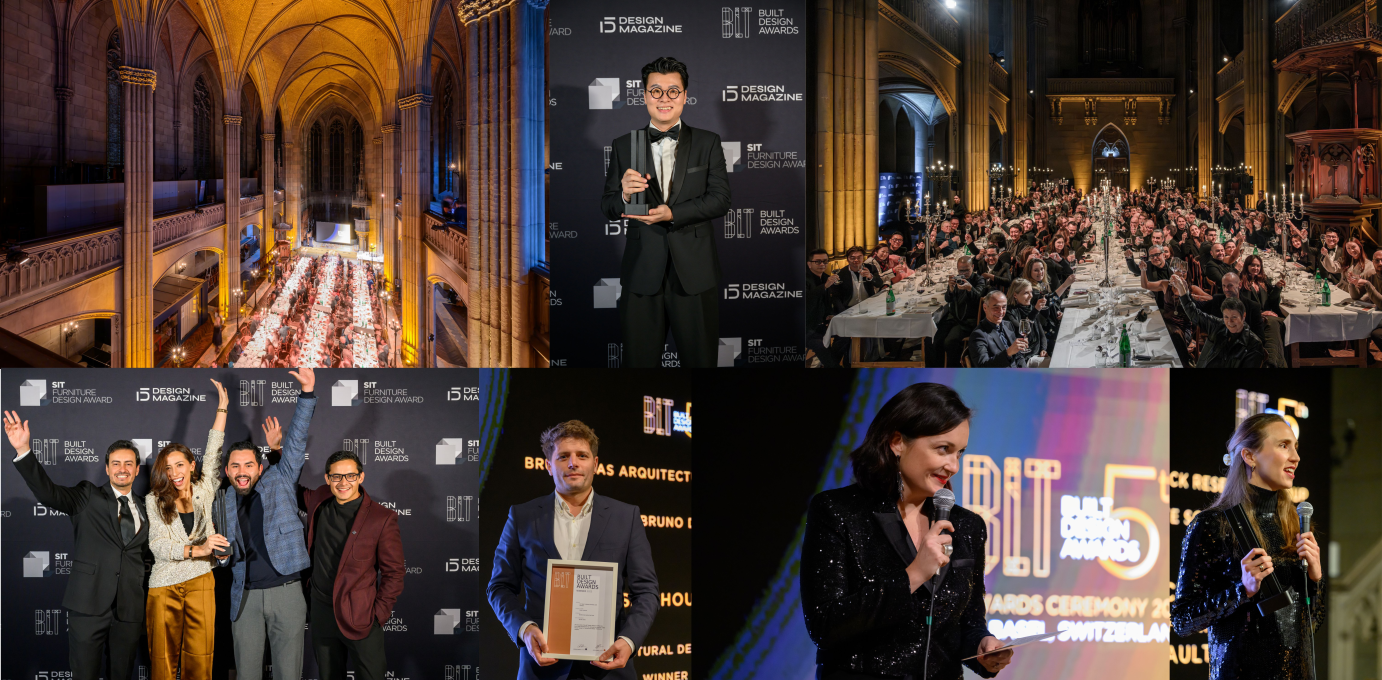
Speaking about the scale of the evening, Astrid Hébert shared: “Standing inside the Elisabethenkirche and seeing designers, students and partners from all over the world gathered in one place was incredibly moving. Bringing the BLT Built Design Awards and the SIT Furniture Design Award together in this historic venue made the scale of the evening truly sink in, and I felt deeply grateful for the energy in the room and for everyone who travelled so far to celebrate with us at the biggest and most inspiring ceremony we have ever hosted.”
This year’s ceremony was supported by media partners including D5 MAG and v2com, marking another year of international collaboration and visibility for the award winners and their work. To explore the winning projects, keep up with upcoming deadlines or get involved in future editions, visit the official award websites and stay part of the global design community.
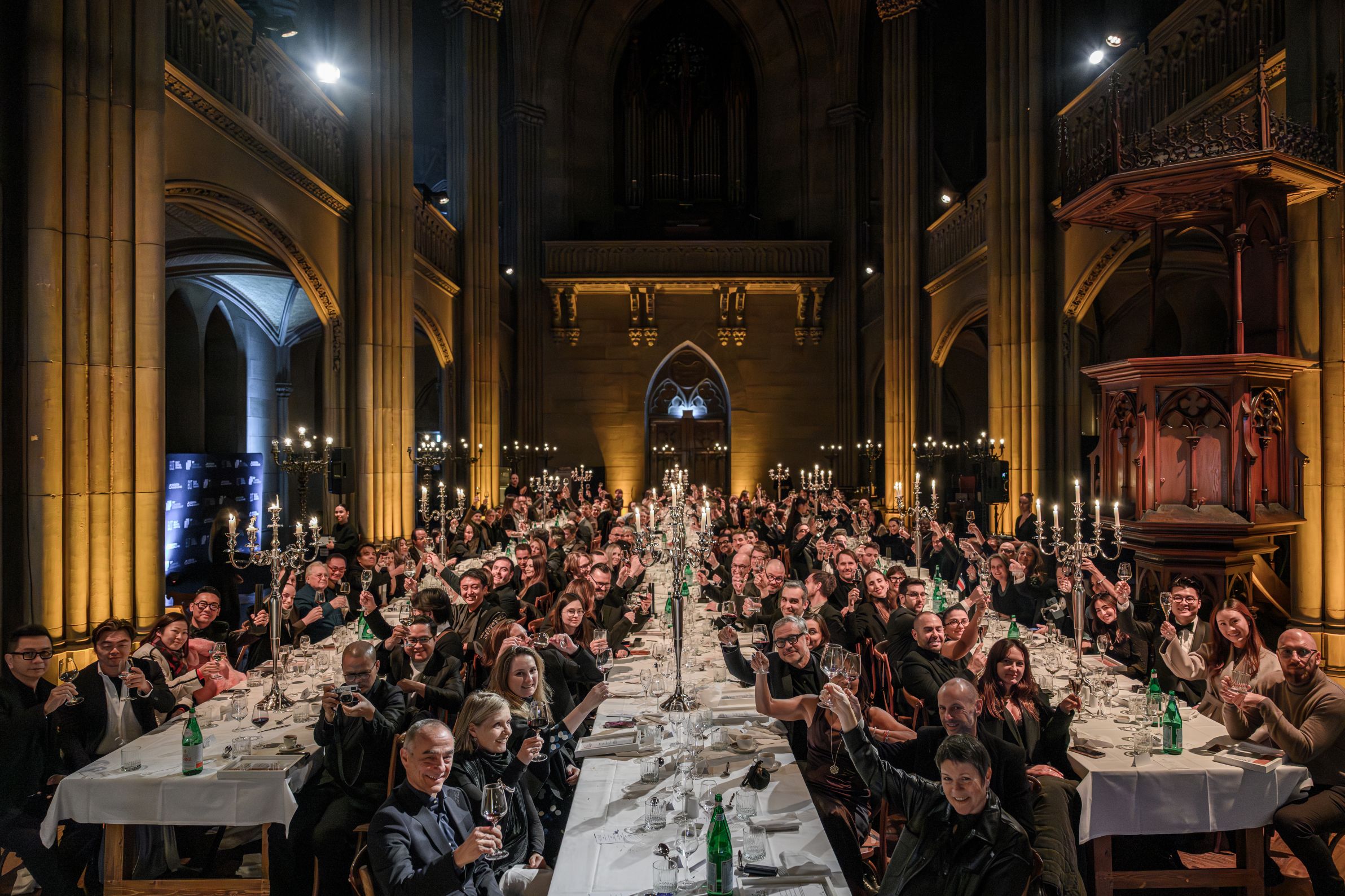
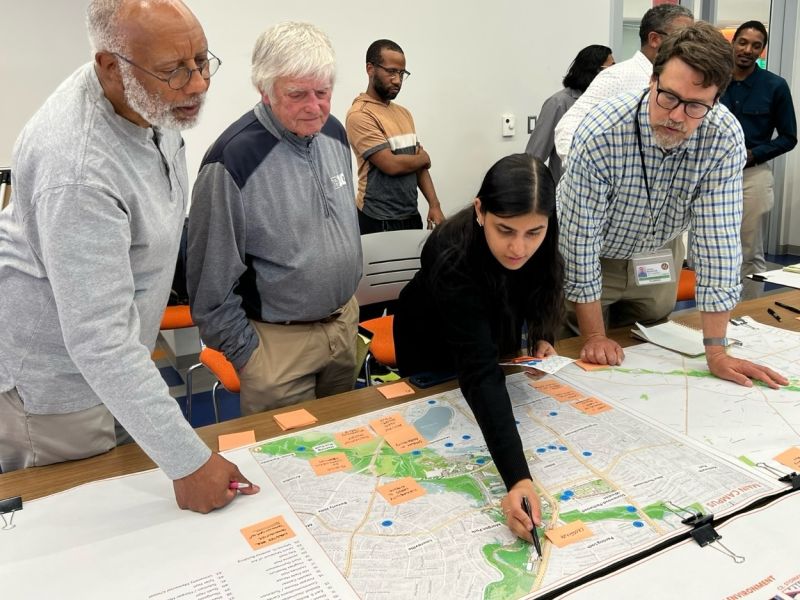 Your career covers architecture, urban design, and data strategy across several continents. What has been the most defining pivot moment in your journey so far?
The most defining pivot in my journey was realizing that design’s true power lies beyond buildings and aesthetics. It lies in shaping systems that sustain both people and the planet.
During my time at MIT, I worked on interdisciplinary projects that bridged design, data, and social innovation to drive climate and community impact. Translating research into spatial and analytical frameworks reshaped my understanding of design from creating form to cultivating systems of care. That insight continues to guide my work today, where I lead initiatives that connect regenerative design, climate resilience, and inclusive community engagement. For me, meaningful design begins with listening deeply, revealing unseen patterns, and co-creating with those most affected by change.
You have led projects across geographies, including the United States, India, and Japan. How does working in different cultural and ecological contexts influence your design methodology?
Working across cultures has profoundly shaped how I design. Moving between contexts has felt less like shifting identities and more like weaving them together, with each place adding a new layer to how I understand people, ecology, and place.
In India, I grew up surrounded by a deep sense of community and resourcefulness that taught me how creativity thrives within constraints. In Japan, I learned the quiet discipline of design and the value of precision, patience, and humility. In the United States, I found the freedom to experiment, to question, and to lead through collaboration.
These experiences coexist rather than replace one another. Whether designing a campus, a neighborhood, or a regional plan, I begin by listening to the culture, the climate, and the land. I then translate that understanding into strategies that balance global knowledge with local identity and context.
Designing for campuses, institutions, and urban systems adds a layer of complexity beyond conventional architecture. How do you create environments that serve both people and long-term functionality?
I see campuses and cities as living systems rather than static plans. They evolve continuously, shaped by social behavior, academic growth, and ecological processes. My design process starts with mapping how people move, gather, and interact across a site and aligning those insights with environmental systems such as water flow, vegetation, and topography.
In many of my projects, the focus has been on revitalization rather than expansion. By restoring natural ecologies, reprogramming existing infrastructure, and integrating flexible spaces for learning and collaboration, we make places that can evolve over time. The measure of success is not just how a space looks on day one but how relevant and resilient it remains for generations to come.
Data is a powerful design tool when used well. Can you share a moment when data completely shifted your approach or revealed something unexpected?
In one of our large-scale campus planning projects, data transformed the way we approached space management and long-term sustainability. By integrating spatial utilization studies with GIS mapping and predictive analytics, we discovered that the campus had nearly a million square feet of underutilized space, even though it was widely perceived to be at capacity.
At the same time, behavioral mapping and engagement surveys revealed deeper social patterns. For example, men and women experienced the same spaces very differently—areas that some described as quiet or peaceful were often perceived by others as isolated or unsafe.
These insights reframed how we defined both efficiency and value. Rather than focusing on expansion, the strategy shifted toward right-sizing existing buildings, introducing adaptive reuse policies, and enhancing open spaces that foster safety, equity, and belonging. The results included significant reductions in operational costs, a smaller carbon footprint, and improved daily experience for the campus community.
This experience reinforced for me that data is most powerful when it is humanized—when it connects quantitative insight with lived experience to create environments that perform better for both people and the planet.
Your career covers architecture, urban design, and data strategy across several continents. What has been the most defining pivot moment in your journey so far?
The most defining pivot in my journey was realizing that design’s true power lies beyond buildings and aesthetics. It lies in shaping systems that sustain both people and the planet.
During my time at MIT, I worked on interdisciplinary projects that bridged design, data, and social innovation to drive climate and community impact. Translating research into spatial and analytical frameworks reshaped my understanding of design from creating form to cultivating systems of care. That insight continues to guide my work today, where I lead initiatives that connect regenerative design, climate resilience, and inclusive community engagement. For me, meaningful design begins with listening deeply, revealing unseen patterns, and co-creating with those most affected by change.
You have led projects across geographies, including the United States, India, and Japan. How does working in different cultural and ecological contexts influence your design methodology?
Working across cultures has profoundly shaped how I design. Moving between contexts has felt less like shifting identities and more like weaving them together, with each place adding a new layer to how I understand people, ecology, and place.
In India, I grew up surrounded by a deep sense of community and resourcefulness that taught me how creativity thrives within constraints. In Japan, I learned the quiet discipline of design and the value of precision, patience, and humility. In the United States, I found the freedom to experiment, to question, and to lead through collaboration.
These experiences coexist rather than replace one another. Whether designing a campus, a neighborhood, or a regional plan, I begin by listening to the culture, the climate, and the land. I then translate that understanding into strategies that balance global knowledge with local identity and context.
Designing for campuses, institutions, and urban systems adds a layer of complexity beyond conventional architecture. How do you create environments that serve both people and long-term functionality?
I see campuses and cities as living systems rather than static plans. They evolve continuously, shaped by social behavior, academic growth, and ecological processes. My design process starts with mapping how people move, gather, and interact across a site and aligning those insights with environmental systems such as water flow, vegetation, and topography.
In many of my projects, the focus has been on revitalization rather than expansion. By restoring natural ecologies, reprogramming existing infrastructure, and integrating flexible spaces for learning and collaboration, we make places that can evolve over time. The measure of success is not just how a space looks on day one but how relevant and resilient it remains for generations to come.
Data is a powerful design tool when used well. Can you share a moment when data completely shifted your approach or revealed something unexpected?
In one of our large-scale campus planning projects, data transformed the way we approached space management and long-term sustainability. By integrating spatial utilization studies with GIS mapping and predictive analytics, we discovered that the campus had nearly a million square feet of underutilized space, even though it was widely perceived to be at capacity.
At the same time, behavioral mapping and engagement surveys revealed deeper social patterns. For example, men and women experienced the same spaces very differently—areas that some described as quiet or peaceful were often perceived by others as isolated or unsafe.
These insights reframed how we defined both efficiency and value. Rather than focusing on expansion, the strategy shifted toward right-sizing existing buildings, introducing adaptive reuse policies, and enhancing open spaces that foster safety, equity, and belonging. The results included significant reductions in operational costs, a smaller carbon footprint, and improved daily experience for the campus community.
This experience reinforced for me that data is most powerful when it is humanized—when it connects quantitative insight with lived experience to create environments that perform better for both people and the planet.
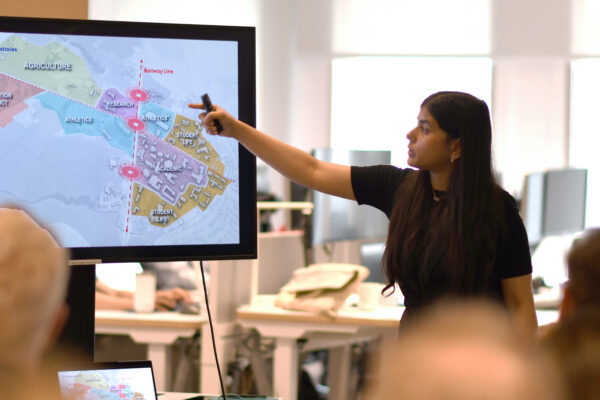 Climate resilience appears in your work not as an add-on but deeply integrated into systems thinking and placemaking. What does true resilience look like to you in the built environment?
To me, true resilience is not about resistance but about regeneration. It is when buildings, landscapes, and communities actively repair the systems they depend on. A resilient environment captures and reuses water, generates its own energy, cools its microclimate through tree canopy and material choice, and restores biodiversity.
Yet resilience is also social. It is about designing spaces that foster belonging, mutual care, and well-being. In my projects, resilience is an ongoing process, not a checklist. It is a culture of stewardship where design is both an ecological and ethical act of renewal.
How do you balance the needs of present-day communities with the adaptability required for a future-proof design?
Balancing today’s needs with tomorrow’s uncertainty begins with empathy and foresight. I start by understanding how communities live, learn, and connect today, and then layer that knowledge with data about climate change, demographic shifts, and new technologies.
Rather than design fixed solutions, I create frameworks that can evolve. Adaptable landscapes, modular buildings, and multi-purpose spaces allow communities to reconfigure their environments as their needs change. Future-proofing is not about predicting the future; it is about building flexibility and care into every decision so that places can adapt gracefully to whatever comes next.
You have won several awards for projects rooted in systemic problem-solving. How do you communicate the value of invisible design, the kind that is felt rather than seen?
Invisible design is where real impact lives. It shows up in the comfort of a shaded courtyard, the calm of intuitive wayfinding, or the quiet efficiency of a restored watershed that prevents flooding. These elements may not always be visible, but they define how people experience and remember a place.
I communicate their value by combining stories and metrics. When we demonstrate that design improves mental well-being, restores biodiversity, or reduces energy demand, it becomes clear that beauty is both functional and emotional. The most successful spaces do not compete for attention; they make everyday life flow with ease.
Climate resilience appears in your work not as an add-on but deeply integrated into systems thinking and placemaking. What does true resilience look like to you in the built environment?
To me, true resilience is not about resistance but about regeneration. It is when buildings, landscapes, and communities actively repair the systems they depend on. A resilient environment captures and reuses water, generates its own energy, cools its microclimate through tree canopy and material choice, and restores biodiversity.
Yet resilience is also social. It is about designing spaces that foster belonging, mutual care, and well-being. In my projects, resilience is an ongoing process, not a checklist. It is a culture of stewardship where design is both an ecological and ethical act of renewal.
How do you balance the needs of present-day communities with the adaptability required for a future-proof design?
Balancing today’s needs with tomorrow’s uncertainty begins with empathy and foresight. I start by understanding how communities live, learn, and connect today, and then layer that knowledge with data about climate change, demographic shifts, and new technologies.
Rather than design fixed solutions, I create frameworks that can evolve. Adaptable landscapes, modular buildings, and multi-purpose spaces allow communities to reconfigure their environments as their needs change. Future-proofing is not about predicting the future; it is about building flexibility and care into every decision so that places can adapt gracefully to whatever comes next.
You have won several awards for projects rooted in systemic problem-solving. How do you communicate the value of invisible design, the kind that is felt rather than seen?
Invisible design is where real impact lives. It shows up in the comfort of a shaded courtyard, the calm of intuitive wayfinding, or the quiet efficiency of a restored watershed that prevents flooding. These elements may not always be visible, but they define how people experience and remember a place.
I communicate their value by combining stories and metrics. When we demonstrate that design improves mental well-being, restores biodiversity, or reduces energy demand, it becomes clear that beauty is both functional and emotional. The most successful spaces do not compete for attention; they make everyday life flow with ease.
 As a BLT jury member, what excites you in the next generation of architects and designers? What ideas or qualities do you hope to see more of in future submissions?
I am inspired by BLT project entries who blur boundaries and see architecture as part of a larger ecosystem that includes policy, technology, ecology, and culture. The next generation brings a clarity of purpose that feels both urgent and hopeful.
I hope to see more projects that measure success by impact rather than image. The best work today restores instead of extracts and invites participation instead of exclusion. It embraces empathy, experimentation, and systems thinking. What excites me most is seeing young designers recognize that creativity and responsibility are not opposites but partners in shaping a more rege
As a BLT jury member, what excites you in the next generation of architects and designers? What ideas or qualities do you hope to see more of in future submissions?
I am inspired by BLT project entries who blur boundaries and see architecture as part of a larger ecosystem that includes policy, technology, ecology, and culture. The next generation brings a clarity of purpose that feels both urgent and hopeful.
I hope to see more projects that measure success by impact rather than image. The best work today restores instead of extracts and invites participation instead of exclusion. It embraces empathy, experimentation, and systems thinking. What excites me most is seeing young designers recognize that creativity and responsibility are not opposites but partners in shaping a more rege
Switzerland, 10 October 2025 — The BLT Built Design Awards 2025 have recognised a new cohort of designs that push architecture and construction forward. Hosted by the 3C Group, the awards celebrate excellence across architecture, interiors, landscapes and construction products. This year’s programme drew entries from 68 countries and received almost 900 projects, illustrating the event’s global reach and the diversity of its participants.
At the centre of the honours is the Architectural Design of the Year, which went to Zaha Hadid Architects for the King Abdullah Financial District Metro Station in Riyadh, Saudi Arabia. The station is part of the world’s longest driverless transit system and serves as a critical interchange. Its three-dimensional lattice encases platforms across four levels, optimising pedestrian circulation. Perforated concrete panels reinterpret traditional regional screens to reduce solar gain, and high-efficiency cooling and passive design strategies helped the building achieve LEED Gold certification.
The Interior Design of the Year accolade went to Aatma Manthan Museum, designed by Sanjay Puri Architects. Located within a 270‑foot‑high statue in Nathdwara, Rajasthan, the museum encourages self‑reflection. Its designers overcame an irregular floor plan and multiple structural elements by orchestrating a sequential flow through 18,000 ft² of galleries, using a neutral palette that enhances audio-visual experiences and guides visitors through the soul (aatma), mind (mana), and body (tann).
In the landscape category, LANDPROCESS earned Landscape Architecture of the Year for its regenerative redesign of the Thailand Government Complex in Bangkok. Led by Kotchakorn Voraakhom, the project reclaimed 18.5 acres of impermeable surface to create green plazas, vertical gardens, and rainwater systems. Solar panels now supply more than half of the complex’s energy needs, and the use of recycled materials reinforces its focus on resilience, while open public spaces strengthen the connection between the government and its citizens.
The Construction Product Design of the Year title was awarded to VINE, a collaboration between the University of Ulsan and Studio Kwan. This innovative façade system draws inspiration from climbing plants: curved, multi-angled photovoltaic modules, produced using large-scale robotic 3D printing, form a skin that both generates energy and visually expresses organic growth. The modules nearly double the summer efficiency of conventional panels and can be replaced individually.
While the top trophies recognise global practices, the BLT Awards also celebrate the next generation. Unfold Form, a lightweight, curved-crease formwork system developed at ETH Zurich, with a lead designer Lotte Scheder-Bieschin, earned the Emerging Architect of the Year title for dramatically reducing the use of concrete and steel. In the Emerging Interior Design category, Symphony – Museum of South African Languages, by Lisa Van Staden of the Cape Peninsula University of Technology, impressed the jurors with its timber and rammed-earth construction, which represents the diversity and rhythm of voices and languages. Harvest Circuit, designed by Ho Sin Chang at Chung Yuan Christian University, envisioned a night market-inspired tower that integrates vertical farming, hydroponics, and rainwater recycling into a dense urban fabric. These student projects show how fresh ideas are reimagining sustainable construction, public engagement, and food production.
After announcing the winners, co-founder Astrid Hébert spoke about the caliber of participants and internationally recognized firms represented this year. “When I look at the submissions this year, I can’t help but feel proud and humbled. We received more entries than ever before, and the calibre of work, from internationally recognised firms to emerging talents, has been extraordinary. Seeing so many familiar names and new voices join us shows how our community continues to grow. I’m truly looking forward to bringing everyone together at the ceremony next month to celebrate the creativity and hard work that went into these projects.”
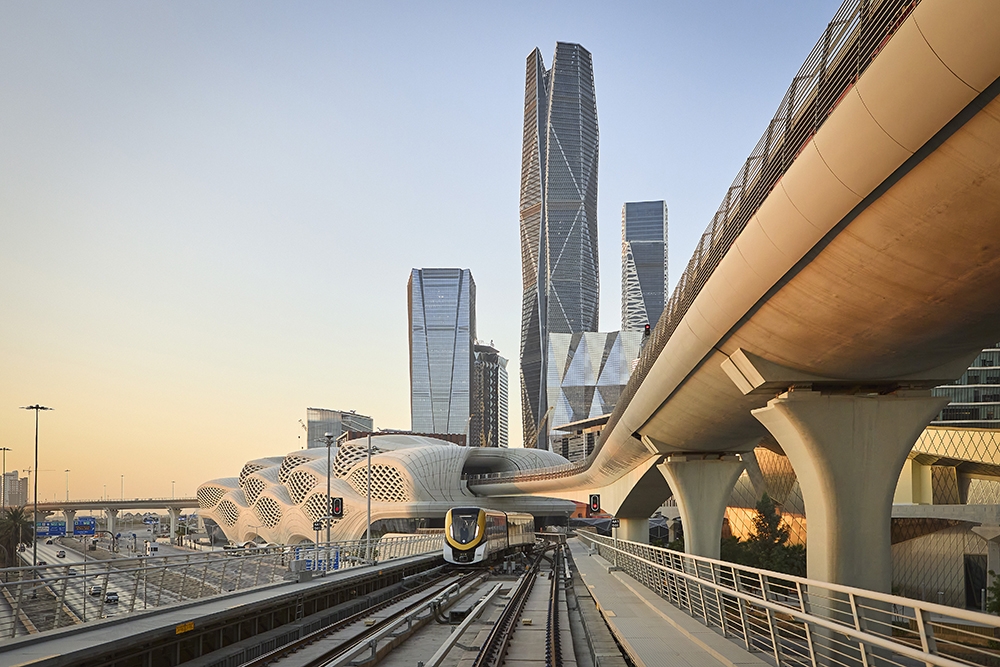
King Abdullah Financial District Metro Station
The winners’ list extends far beyond these titles. Zaha Hadid Architects, for example, also took honours for the Shenzhen Science & Technology Museum (cultural category) and the Capital International Exhibition & Convention Centre (mixed‑use building). Sanjay Puri Architects added a residential win with NINE × NINE. The Dutch partnership of Benthem Crouwel Architects & West 8 secured the Bridges and Public Infrastructure award for Brno Main Station. Other notable winners covered several continents.
Beijing Do Union Architecture Design Ltd. earned a cultural win for the Beijing 751 Library. TAHR Arquitectura from Mexico was honoured for Ananas Spa Cotton Bay in the healthcare and wellness facilities category; Korea’s On Architects Inc. impressed with Wall·Line·Garden and Canada’s Akb Architects won with Sagamore North Cottage; Aristides Dallas Architects of Greece received recognition for the residential project TERRA FRACTA; the German studio TCHOBAN VOSS Architekten GmbH was honoured for Dockyard and for the SAB office building in Berlin; the Austrian firm Baumschlager Eberle Architekten won for Maison de l’Innovation; Taiwan’s JJP Architects and Planners took commercial honours with the KANTO PPC Taoyuan Headquarters; Sheppard & Rout Architects of New Zealand were recognised for the Punangairi Visitor Centre; Paul Murdoch Architects from the United States won in the cultural category for The New Museum of Architecture and Design; and China’s Big Valley Architectural Design Co., Ltd. was awarded for the Zhou Gong Mountain International Conference Center in Ya’an, Sichuan. These results show the variety of distinguished practices celebrating excellence across sectors such as cultural, commercial, residential, healthcare and industrial projects, and underscore how the BLT Awards attract both established studios and innovative new voices.
Founded to honour exemplary contributions to the built environment, the BLT Built Design Awards rely on a diverse jury of architects, designers, developers, academics, and media representatives who rigorously evaluate submissions. Among them were Eduardo Salgado Mordt, Partner at LACAL Architektur GmbH; Samantha Lassoudry, Founder and Chief Designer of Lassoudry Architects; Andreas Rupf, Head of ETH RAUM and Founder of SPEKTRUM GmbH; Mona Vijaykumar, Associate Urban Designer at Perkins&Will; Muhammad Habsah, Director of U+A, part of the 10N Collective; Serhii Makhno, Founder of MAKHNO Studio; Juliet Kavishe, Executive Board Member of the Pan Afrikan Design Institute; Stanislas Helou, Founder of Thinking Luxury; Sonsoles Vela Navarro, Founding Partner of studioVRA and Associate Director of Architecture at Tulane University; and Rudi Stouffs, Dean’s Chair Associate Professor and Assistant Dean (Research) at the College of Design and Engineering, National University of Singapore.
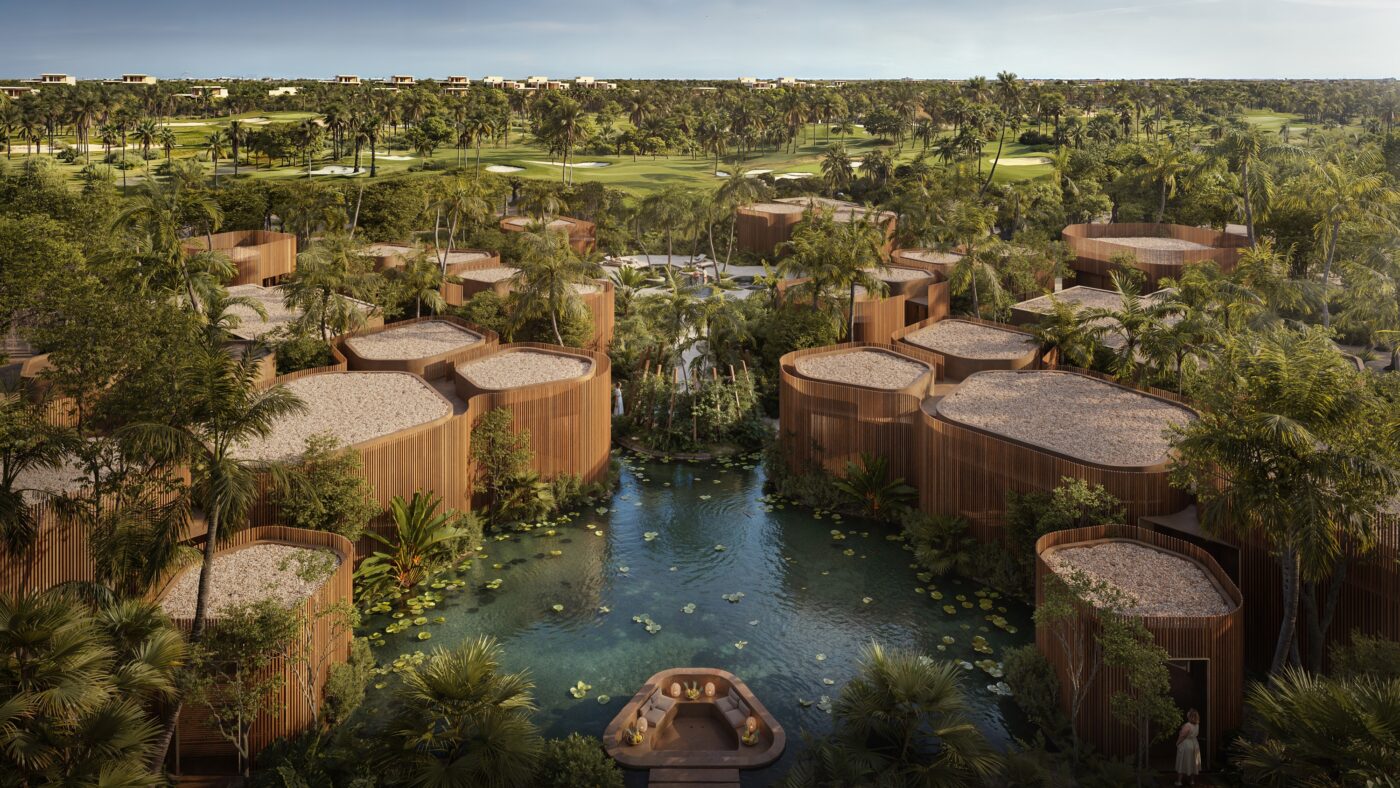
Ananas Spa Cotton Bay @ Raum Visual, Javier Rabadan, Flow, Studio Gronda
Winners gain international visibility on the BLT website, appear in the annual Book of Design and receive the distinctive BLT trophy. The 2025 honourees will be celebrated at a gala ceremony this November in Basel, Switzerland, where the international design community will come together to applaud their achievements. The event will not only recognise the winning projects but also serve as a gathering of industry leaders, a chance to exchange ideas, and an opportunity to showcase how design continues to shape our future. For a complete list of winners, visit the BLT Awards website at bltawards.com.
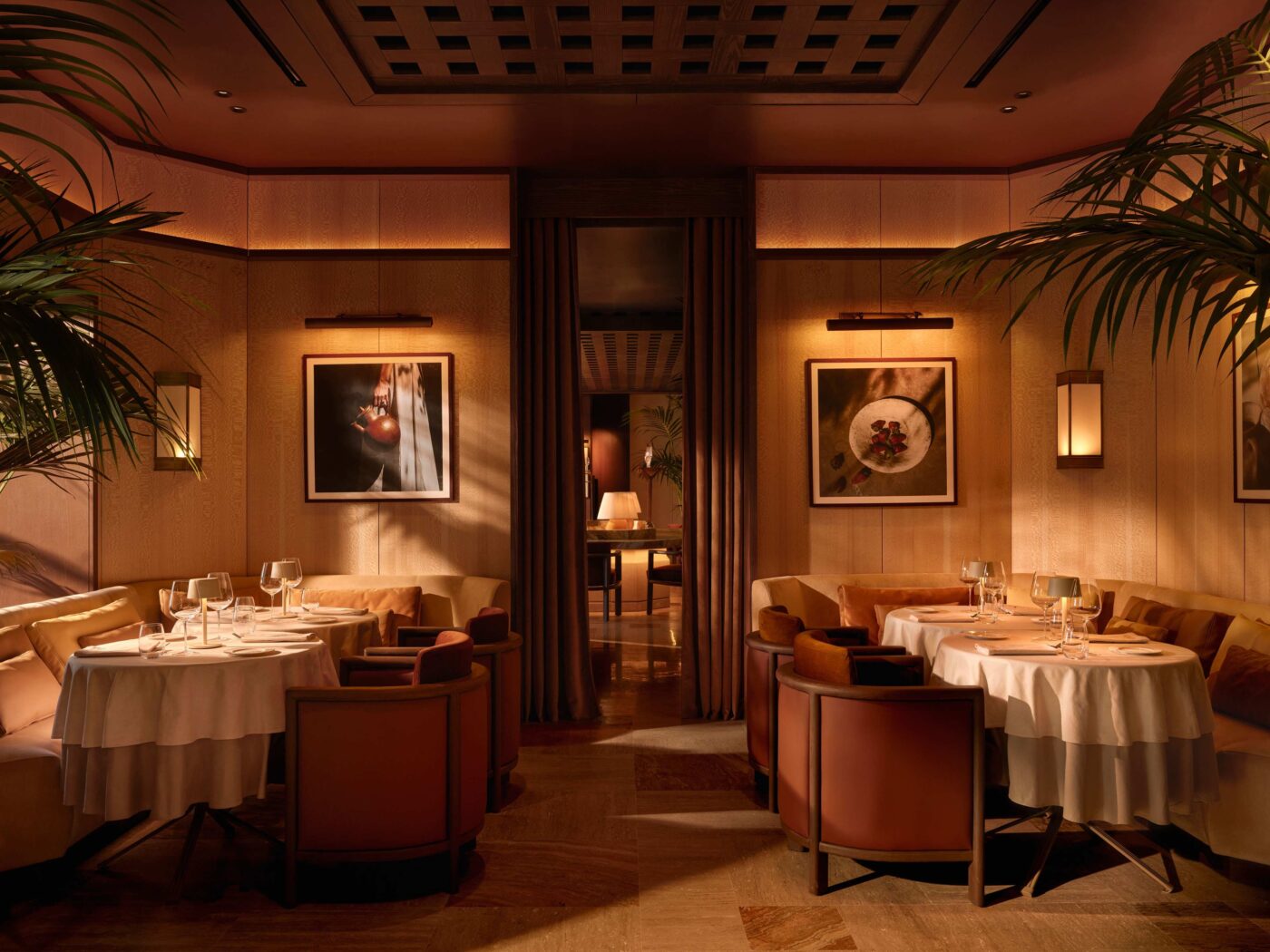
ESCA @Ibrahim Özbunar I 645studio
The BLT Built Design Awards, which celebrate exceptional contributions in architecture, interior design, construction products, and landscape architecture, have announced a remarkable panel of new jury members for its 2025 edition. These distinguished professionals join a stellar international jury to honour the vision, creativity, and passion driving the built environment forward.
This year, the BLT Awards welcome Tran Ngoc Danh, Vice President of VDAS Vietnam Design Association and Founder & CEO of the VMARK Vietnam Design Award. With over three decades of experience, Ms. Tran has been a transformative force in Vietnam’s design community. From the United States, Cas Esbach, founder of KANS and professor at SCAD, brings his expertise at the intersection of practice and pedagogy. His work explores the role of AI in architectural authorship, combining bold experimentation with global narratives that challenge and enrich our understanding of design today. Muhammad Habsah, Design Director at U+A (part of the 10N Collective), is a driving advocate for socially conscious and culturally resonant design. His award-winning work across the GCC and Africa reflects a deep respect for heritage, sustainability, and inclusivity.
Joining from Perkins&Will in Boston, Associate Urban Designer Mona Vijaykumar is known for her award-winning projects across the United States, India, and the Middle East. Christian Brendelberger, Head of Cost Planning and Executive Board Member at Dietziker Partner Baumanagement AG in Switzerland, brings decades of experience in steering large-scale projects with economic precision and creative support for design architects. From ETH Zurich, Andreas Rupf, Head of ETH RAUM and Founder of SPEKTRUM GmbH, has dedicated his career to sustainable spatial development and participatory urban planning. International urban planner and designer Anastasia Ignatova joins the jury with a wealth of experience from her humanitarian and development work across Asia, Africa, and Europe.
Amir Idiatulin, Founder and CEO of IND, leads one of Russia’s most acclaimed architectural firms with over 150 realized projects worldwide. From the National University of Singapore, Rudi Stouffs, Dean’s Chair Associate Professor and Assistant Dean (Research), brings expertise in digital resilience, sustainable urbanism, and computational design. His research and leadership at the interface of technology and architecture shape future-ready cities and resilient communities. Nigerian interior designer Osaru Alile, Principal Partner at CC Interiors Studio, infuses creativity and African storytelling into harmonious, functional spaces.
These acclaimed professionals join an already distinguished jury composed of some of the most respected names in the global design and architecture community. Returning jurors include Sandra Baggerman of Trahan Architects (USA), a renowned architect and tutor celebrated for her thoughtful approach to contemporary practice; Serhii Makhno, founder and owner of MAKHNO Studio (Ukraine), acclaimed for his distinctive fusion of Ukrainian traditions and modern aesthetics; and Hannah Churchill, founder and design director of hcreates interior design (China), known for her innovative and award-winning hospitality and commercial spaces across Asia.
The panel also includes Stanislas Helou, founder of Thinking Luxury (Andorra), whose expertise bridges luxury, strategy, and cultural insight, and Sonsoles Vela Navarro, founding partner of studioVRA and associate director of architecture at Tulane University (USA). Other esteemed members contributing their unique expertise are Eason Zhu of Fununit Design (China), Ruben Garcia Rubio of studioVRA and Tulane University (USA), Colleen Cocotos of Cape Peninsula University of Technology (South Africa), Steffen Lehmann of si_architecture + urban design and University of Nevada (USA), Dave Pigram of supermanoeuvre (Australia), Valeria Senkina of Dseesion Interiors (Russia), Dan Grimshaw of BEAM Development (UK), Kourosh Salehi of LWK + PARTNERS (UAE), and Lichen Ding of DLCA Architects (China).
Astrid Hébert, Program Director of the BLT Built Design Awards, shared:
“It is a pleasure to welcome such a talented and inspiring group of professionals to the BLT jury this year. Their diverse perspectives and dedication to meaningful design perfectly reflect the values of our awards. I’m very much looking forward to meeting everyone in person at our ceremony in Basel, where we will celebrate the creativity and passion driving the future of the built environment.”
This extraordinary and diverse group brings unmatched expertise, cultural richness, and creative vision to evaluate this year’s submissions with rigor, insight, and fairness.
With such an accomplished jury ready to honour the very best in design and the built environment, the BLT Built Design Awards invite you to submit your project before the final deadline of August 26th. Take this opportunity to have your work reviewed by world-class experts and celebrated on a global stage. Submit today and let your vision shine. Discover the complete jury lineup and find out how to submit your project by visiting the website: bltawards.com.
The BLT Built Design Awards have officially announced the date and location for their annual awards ceremony and gala dinner. Set to take place on Friday, November 21st, 2025, the event will be hosted at Elisabethenkirche in Basel, Switzerland, a striking example of adaptive reuse architecture and one of the city’s most iconic cultural venues.
Organized by 3C Awards, the ceremony will celebrate the achievements of 2024 and 2025 BLT Awards winners across four key disciplines: Architecture, Interior Design, Landscape Design, and Construction.
This year’s venue, a 19th-century neo-Gothic church reimagined as a contemporary event space, mirrors the core values of the BLT Awards, honoring tradition through innovation. The setting also aligns with one of the most relevant conversations in the field today: adaptive and reuse architecture.
The evening will include formal trophy presentations, a seated gala dinner, and a showcase of the winning projects. Attendees will have the opportunity to network with fellow laureates, jury members, media representatives, and the organizing team. All winners attending the event will be invited on stage to receive their certificates and will have their projects featured throughout the evening.
Each winning firm will receive two complimentary tickets to attend the ceremony. The reservation platform is scheduled to open in August, with additional details to follow.
With a global community of designers expected to gather in Basel, the 2025 BLT Built Design Awards Ceremony promises to be both a celebration of excellence and a platform for dialogue around the future of the built environment.

We are thrilled to announce the launch of the BLT Built Design Awards Winners 2024 Catalogue, now available for free download on our website or for purchase on Amazon worldwide.
This exclusive publication showcases the exceptional projects and innovations honored in this year’s awards, spanning Architectural Design, Interior Design, Landscape Architecture, and Construction Product Design. Inside, you’ll find inspiring interviews and groundbreaking designs that push the boundaries of creativity and functionality.
The BLT Built Design Awards celebrate the expertise of professionals shaping the built environment—visionary architects, interior designers, landscape architects, and construction innovators—who tackle today’s urbanization challenges and pave the way for the future.
Could you walk us through your vision and guiding principles behind the WOSA Sintered Stone Showroom?
Our design philosophy emphasizes that every showroom should not only highlight the best qualities of the products on display but also leave a lasting impression on visitors. For the WOSA Sintered Stone Showroom, our vision is to transform stone into a work of art, showcasing its thinness, texture, and moldable form.
We aim to create a space that merges aesthetics, craftsmanship, and spatial exploration, akin to entering a stone museum. This environment allows visitors to explore, discover, enjoy, imagine, and experience the beauty of stone materials in a new light.
In this project, we are redefining retail experiences for the modern customer, moving away from traditional sales techniques and typical display shelves. Our goal is to craft an unforgettable experience that transcends the status quo, inviting visitors to engage with the materials in a meaningful way.
How did you ensure that the creative elements of the design remained practical for a retail environment?
To ensure the creative elements of our design were practical for a retail environment, we adopted a collaborative approach. We worked closely with in-house staff and sales teams to understand the retail logic, typical settings, and existing challenges they face.
Additionally, we conducted in-depth discussions and workshops with the manufacturing team to gain insights into the characteristics of their products, including their strengths and weaknesses. Engaging with company leaders was crucial for understanding their future plans, branding strategies, and market sectors.
Through this comprehensive research and dialogue, we were able to balance their needs with technical considerations. Our expertise in architecture, interior design, and product design allowed us to develop a brand image that aligns with their expectations while incorporating about 20% creative elements. This approach enabled us to deliver results that exceeded their expectations, blending creativity with practicality seamlessly.
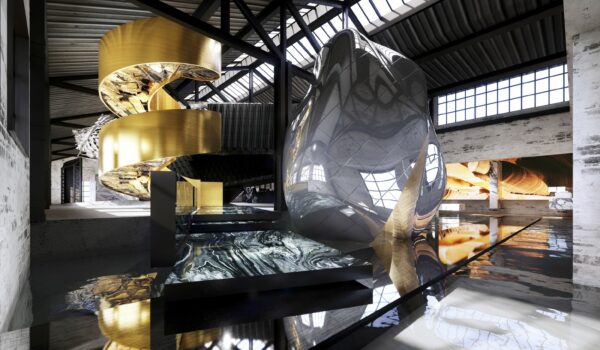
WOSA Sintered Stone Showroom, The Volks Design Research & Consulting Ltd.
Can you tell us how each element works together to leave a lasting impression on visitors?
From the moment visitors arrive, they are greeted by an artful space that sets the tone for their experience. Upon entering, they encounter various architectural forms, each made from unique materials. While these structures may look distinct, they are all designed with a cohesive methodology that visually connects them.
This design approach can be likened to a classical music composition, where different architectural elements represent different tones yet share a common rhythm and logic that creates a harmonious whole. The showroom offers a creative journey that excites visitors at every turn, whether they are ascending or descending within the space.
As they explore, visitors come away with the impression of having visited a museum, where each artwork presents a unique artistic expression around a shared theme. This thoughtful integration of elements ensures that their experience is not only memorable but also deeply engaging, leaving a lasting impression.
You’ve described this project as a kind of “journey” for visitors. How do you hope customers and industry professionals interpret the experience?
This project is designed not as a typical sales platform that merely displays products along a wall but as a stone museum resembling a cityscape. Here, customers and visitors are encouraged to explore and engage with the space at their own pace, free from the pressure of making immediate purchases.
The experience is akin to a journey, where each stop offers something unique—be it insights into the products, their applications, colors, textures, shadows, reflectivity, or forms. Each product is presented as a small piece of architecture, showcasing its versatility and potential uses.
In certain designated areas, we plan to periodically collaborate with different artists to transform products into art pieces, further enriching the experience. We hope this project inspires industry professionals to think beyond traditional retail spaces, envisioning them instead as environments that enhance the urban experience or function as public spaces. Ultimately, we aim for visitors to leave with a deeper appreciation of the materials and their artistic potential.
With the WOSA Sintered Stone Showroom set within a repurposed factory, how did the original architecture of the space influence your design decisions?
The WOSA Sintered Stone Showroom is intentionally located within a repurposed factory, and this historical context significantly influenced our design approach. Rather than obscuring the original architecture with new materials, we chose to embrace its authentic character.
We left most of the existing flooring untouched, as we believe the wear and patina of time tell a story that cannot be replaced. Our design philosophy celebrates the history of the space; we liken ourselves to archaeologists who carefully excavate and highlight the original features. This includes preserving elements like existing graffiti and the structural integrity of the building while thoughtfully removing later additions that detracted from its character.
By juxtaposing old and new elements, we aim to create a richer, more memorable experience for customers. The contrast enhances the appreciation of both the historical context and the innovative design of the showroom, allowing visitors to connect with the space on multiple levels.
How have your previous experiences influenced your approach to a project like this?
My previous experiences have profoundly shaped my approach to projects like the WOSA Sintered Stone Showroom. With an architecture degree from Harvard and a background working with renowned firms such as Foster and Partners and Sasaki, I bring a unique perspective to each interior project. I view interiors not just as isolated spaces but as integral parts of a larger urban fabric, where each element functions like architecture within a city.
In this project, the layout is intentionally designed to mimic a city, featuring plazas, visual corridors, and distinct architectural forms at varying levels. This arrangement creates an engaging environment that encourages exploration and interaction.
Additionally, my roots in Macau have deepened my appreciation for history and the rich textures of old architecture. After years in modern urban settings, returning to Macau allowed me to recognize the beauty in its historic streets and buildings. This appreciation is evident in the showroom design, where elements of old and new coexist harmoniously, inviting visitors to engage with the layered history of the space. Ultimately, these experiences inspire me to create environments that are both innovative and reflective of their cultural context.
Winning the “Interior Design of the Year” at the BLT Built Design Awards is significant. In your view, what aspects of the showroom design do you believe set this project apart in the eyes of the judges?
Thank you for recognizing our achievement in winning the “Interior Design of the Year” at the BLT Built Design Awards; it is indeed a significant acknowledgment. I believe what sets this showroom apart is its departure from the conventional showroom model. It transcends mere decoration and showcases a strong spatial composition and diversity.
Instead of presenting products in a straightforward manner, this project takes creative risks by expressing each product with its own unique language and form, allowing for an artistic interpretation that plays with light and shadow. The integration of architectural elements with an artistic approach creates a dynamic environment that engages visitors in a meaningful way.
This blend of innovative design thinking and artistic expression likely resonated with the judges, highlighting how we can redefine retail spaces to be more immersive and experiential. The showroom is not just a place to view products but a thoughtfully curated journey that invites exploration and appreciation of the materials and their artistic potential.
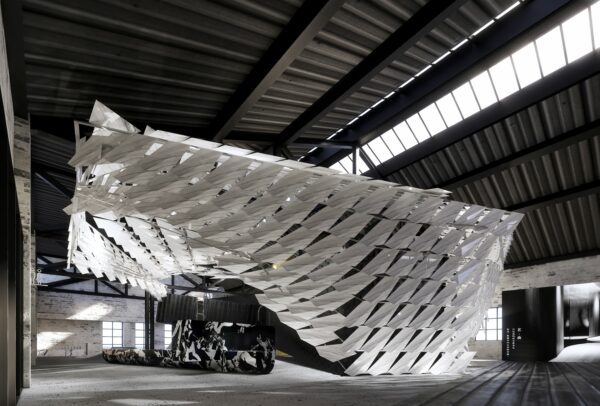
WOSA Sintered Stone Showroom, The Volks Design Research & Consulting Ltd.
Looking forward, how do you see showrooms evolving in the interior design industry? What might retail spaces need to do to stay innovative and relevant?
As AI and technology-driven selling platforms continue to advance, consumer spending habits are changing dramatically. Future showrooms will need to evolve from mere display spaces into environments that offer enjoyment, leisure, and opportunities for gathering. They may even transform into public spaces that foster community engagement.
Innovation will be essential for retail spaces to remain relevant. This innovation will likely stem from diversity, cross-disciplinary collaboration, and a willingness to experiment. Retail environments must deliver experiences that exceed customer expectations, creating a sense of discovery and engagement.
By integrating interactive elements, immersive design, and a focus on customer experience, showrooms can become destinations in their own right. This shift will not only enhance the retail experience but also position these spaces as vital contributors to the cultural and social fabric of their communities. Ultimately, the key will be to create environments that resonate with customers on multiple levels, making them feel valued and connected.
Blending harmoniously into the surrounding Leoganger Steinberge mountain range, ATMOSPHERE by Krallerhof creates a year-round space for relaxation and regeneration. Designed by Hadi Teherani Architects, this adult-exclusive spa builds on the tradition of luxury accommodation at Hotel Krallerhof, a five-star retreat opened by the Altenberger family in 1956.
Winner of the Architectural Design of the Year at the BLT Built Design Awards, ATMOSPHERE showcases the power of sustainable materials in modern architecture. Its terraces, crafted from Kebony wood, embody the project’s dedication to blending beauty, functionality, and environmental responsibility.
In this interview, Marvin Uwe Grawe, Objects Consultant Architecture for Kebony, shares insights into the challenges of designing for an alpine environment and how the project sets a new standard for sustainable wellness design.
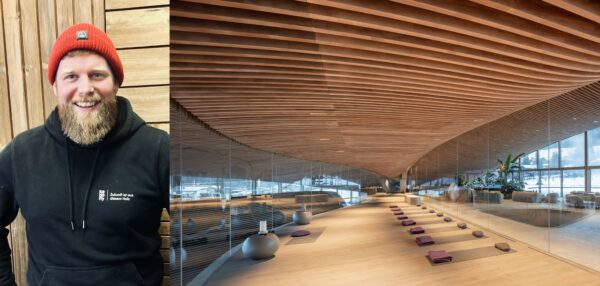
Marvin Uwe Grawe, Objects Consultant Architecture for Kebony // ATMOSPHERE by Krallerhof, HGEsch Photography.
The terrace areas of ATMOSPHERE are a central element of its design. In your opinion, what makes Kebony wood the perfect choice for this award-winning space?
Kebony wood meets the high demands of modern architecture in terms of durability and aesthetics with exceptional results. Its warm, natural appearance complements ATMOSPHERE’s contemporary design while seamlessly blending into the alpine landscape.
Looking at the material requirements of ATMOSPHERE’s terrace, most outdoor pools are used during the hottest months when materials like stone and concrete can become uncomfortably hot and slippery, posing a risk of falls. A wooden pool deck offers a safer, more comfortable alternative, staying cooler under the sun and providing a soft, non-slip surface for walking by the water.
During the freezing months of Austria, however, the outdoor facilities at ATMOSPHERE come under different stresses, with sub-zero temperatures turning surface water to ice and putting the decking under conditions where other wooden materials may splinter and risk harm to guests.
In this context, a quality and unique decking solution was required; Kebony was perfectly placed to help fulfill these needs and the overarching vision for this world-leading project.
The terrace is exposed to constant moisture, sunlight, and even snow at times. How did you ensure that Kebony wood retains its quality and beauty in such a challenging environment?
Kebony’s bio-based Dual Modification™ technology permanently transformed the cell walls of the wood decking by forming locked-in furan polymers, increasing the dimensional stability, durability, and hardness of the wood. The reaction with OH-groups present in the wood reduces the water sensitivity significantly, making Kebony wood decking resistant to 24/7 exposure next to the pool and the seasonal vagrancies of the weather, therefore guaranteeing a high degree of safety.
The added resistance given by the dual modification™ process also means the Kebony decking requires little to no maintenance following installation, bypassing the need for any extended periods of ATMOSPHERE’s closure to treat the decking. For a project like ATMOSPHERE, this means the terrace remains durable under the harshest conditions while developing an elegant silver-grey patina over time, creating aesthetic harmony with the alpine surroundings.
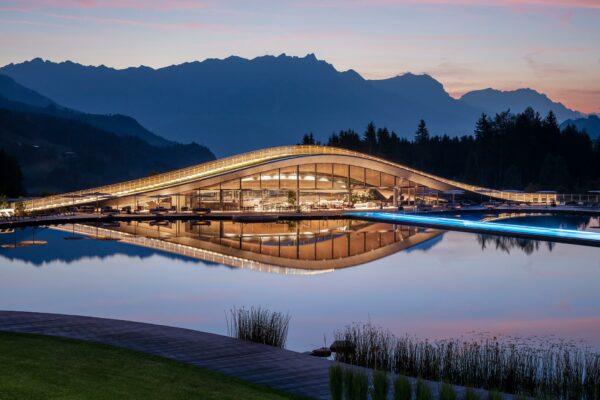
ATMOSPHERE by Krallerhof, HGEsch Photography.
What unique challenges or surprises did Kebony face while working on ATMOSPHERE, and how did you address them?
The greatest challenge was the extreme weather conditions of the alpine location. The material needed to endure harsh climatic stress while also meeting the project’s modern and sophisticated design requirements. To achieve this, we conducted material testing on-site and collaborated closely with Hadi Teherani Architects to identify the best technical and aesthetic solutions. Kebony’s flexibility and versatility allowed us to create a solution that is both functional and visually compelling, even in the most demanding conditions.
The spa is set against the stunning backdrop of the Leoganger Steinberge. How did Kebony ensure that the terrace harmonizes with this landscape?
Kebony wood is valued by architects for its ability to appear as a natural extension of its surroundings. Its capacity to age into an elegant silver-grey patina allows it to blend seamlessly into the alpine setting. For projects like ATMOSPHERE and other large-scale Kebony projects in snowy regions, such as the Lillehammer Winter Youth Olympic Games student village, the wood achieves the perfect balance between architectural elegance and natural beauty without overshadowing the environment—offering architects the freedom to harmonize architecture and landscape. These properties made Kebony the ideal material for ATMOSPHERE to seamlessly blend with the Leoganger Steinberge mountains, as the peaks both rise over ATMOSPHERE and reflect off the water’s surface.
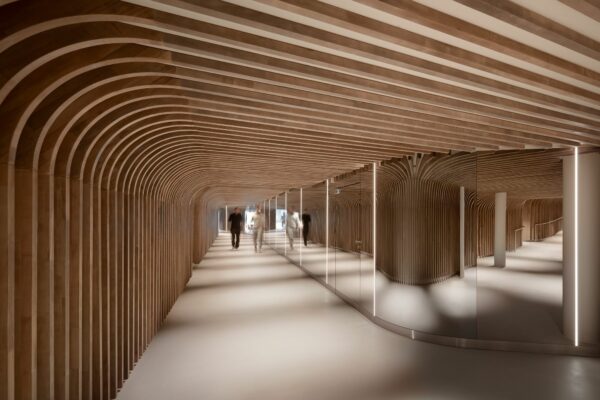
ATMOSPHERE by Krallerhof, HGEsch Photography.
How has Kebony’s technology and material sourcing contributed to reducing the environmental impact of this project?
Kebony is a pioneer in paving the way for healthy architecture and a greener, more sustainable future for the global construction industry. Developed to address the dual issue of deforestation and carbon emissions in construction, Kebony’s dual modification™ technology transforms sustainably sourced FSC-certified softwoods into durable and aesthetically beautiful timber products with the same, and in some cases superior, properties as endangered tropical hardwood species. This supply of environmentally friendly building materials that match quality with sustainability helps to alleviate the deforestation of the planet’s precious rainforest habitats and carbon sinks, such as the Amazon.
Additionally, Kebony’s versatility extends beyond terraces to façades, urban furniture, and even interiors. This adaptability enables architects to incorporate sustainable materials across various applications, making a meaningful contribution to eco-conscious architecture.
Hadi Teherani Architects worked alongside Kebony on the design of ATMOSPHERE. How did this collaboration influence the final result?
It is through the exciting collaboration with Hadi Teherani Architects that we are proud to see the Kebony decking on one of the largest scales of any project in the world. The collaboration was an outstanding example of how innovation and partnership can achieve remarkable outcomes.
What we found particularly remarkable about this project was that sustainability wasn’t just an empty buzzword but a genuine priority from start to finish. The architect’s vision required a material that was not only technically advanced but also supported the aesthetic of a modern spa in an alpine setting.
As Kebony’s architectural advisor, I (Marvin) worked closely with the team to ensure our materials were seamlessly integrated into the design. The result is a space where architecture, nature, and sustainability come together perfectly—a testament to the importance of early collaboration between architects and material experts
Congratulations on winning the BLT Award for “Architectural Design of the Year”! Do you believe this recognition will open new opportunities for Kebony in the wellness and hospitality industry?
Thank you! This award underscores the significance of sustainable materials like Kebony in the architecture of the future—especially in the premium wellness and hospitality sectors. It serves as an encouragement for architects to utilize Kebony in projects that combine durability, sustainability, and aesthetics.
With the growing appearance of new, luxury wellness facilities worldwide built to take advantage of the calming beauty of nature, Kebony wood’s effortless ability to blend in with spectacular natural landscapes positions it as the perfect material for further high-end wellness and hospitality projects across the globe.
What lessons has Kebony learned from this project, and how might these influence your approach to future projects?
ATMOSPHERE highlighted the importance of involving architects early in the material selection process to fully support their design vision. The close collaboration with Hadi Teherani Architects demonstrated that Kebony is ideal, not just for terraces but also for façades, urban furniture, and interiors—areas where design and sustainability must work hand in hand.
For future projects, we will leverage these insights to make Kebony even more adaptable and purpose-driven. We look forward to continuing to provide architects with innovative, sustainable solutions that bring their creative concepts to life.
Chatchanin Sung is the Executive Director and Landscape Studio Director at Arsomsilp Community and Environmental Architect. As a leading female figure in the field, she has profoundly impacted urban design by blending ecological principles with creative architecture. One of her firm’s most celebrated achievements is the transformation of Benjakitti Forest Park in Bangkok, which earned the prestigious Landscape Architecture of the Year 2024 title at the BLT Built Design Awards.
This remarkable project, developed on the site of a former tobacco factory, spans 720,000 square meters. Benjakitti Forest Park addresses flooding and drought issues but also serves as a biodiverse habitat, offering educational opportunities in ecology, hydrology, and sustainable urban development. The design, led by Arsomsilp Community and Environmental Architect in collaboration with TURENSCAPE as the design consultant, employs nature-based solutions inspired by traditional Thai agricultural wisdom, with the park’s “sponge” concept playing a crucial role in absorbing and releasing water, ensuring the park’s vitality year-round.
In this interview, Chatchanin reflects on the creative and technical challenges of transforming the site, the park’s innovative design elements, and the broader lessons that can be applied to urban projects in dense cities. She shares her insights on how Benjakitti Forest Park represents a model for sustainable urban development and her hopes for its future impact on Bangkok and beyond.
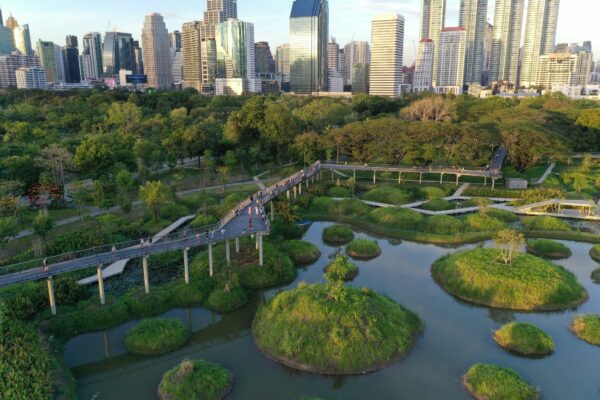
Royal Thai Army – 1st Development Division, Sarakadee Magazine, Mr.Srirath Somsawat
What were some of the biggest challenges you faced when transforming the site, and how did you overcome them?
The biggest challenge was aligning all stakeholders to a shared vision of using the nature-based solution since the initial design for the design competition. Convincing them that this approach is not only feasible but transformative.
Every stage of the process, from design to construction, came with challenges since the concept was new for the entire team. We overcame these challenges by sharing a common goal and working together with experts across fields, from engineers to urban forest experts to local wisdom, to solve problems. To ensure the design’s feasibility, we conducted tests and experiments, including mock-ups and trials of the wetland and natural water filtration system. These tests ensured the wetland’s efficiency in producing clean water, enabling us to realize the concept as planned.
Can you tell us more about the park’s “sponge” concept and how it is effective in an urban environment? How does it meet the specific environmental needs of Bangkok?
Bangkok faces unique urban challenges, including high water tables, being below sea level, and extensive hardscaping, which leads to flooding during rainfall. The sponge concept at Benjakitti Forest Park addresses these issues by absorbing and retaining stormwater, which helps reduce urban flooding.
The park’s design allows water to seep into the ground, functioning as a natural reservoir and stored in the main ponds. The water reservoir is discharged during the dry season, helping to maintain the trees in the park, allowing low maintenance as well as helping cool the surrounding environment during the dry season, counteracting the heat generated by the city’s concrete surfaces.
How did you approach incorporating the park’s old industrial structures into the new design, especially in relation to how trees and plant life interact with these elements?
Our approach was rooted in respect for the site’s history and natural resources. All the existing trees, which are the site’s most valuable assets, were carefully preserved and revitalized. The old industrial structures were also maintained and renovated for new purposes, making them functional and meaningful while encouraging visitors to engage with the park.
New design elements were then added to complement these existing features, making the park more functional with engaging activities for visitors. This blend of old and new created a space that honors its past while serving the community in the present.
How did you balance creating a space that supports the park’s diverse plants and wildlife while also making it accessible and enjoyable for the public?
Our goal was to balance ecological preservation with accessibility by creating zones with varying levels of access. The wildlife sanctuaries are designated as habitats for birds and other wildlife; human access is limited to observation only. Human functional spaces feature open spaces under tree shades, accessible pocket spaces integrated into nature, and inclusive spaces for all.
This zoning ensures that humans and wildlife can coexist, with each respecting the other’s space. The park’s biodiversity, with visits from over 169 bird species, attracts nature enthusiasts, fostering a deeper appreciation for the environment while creating a vibrant community space.

Royal Thai Army – 1st Development Division, Sarakadee Magazine, Mr.Srirath Somsawat
What lessons from this project do you think can be applied to other urban design projects, particularly in dense cities with limited green space?
This project demonstrated that nature-based solutions are a sustainable and effective approach to urban planning, even in densely populated cities. We have seen the importance of incorporating water management systems like wetlands, reservoirs, and permeable surfaces to reduce flooding and test their efficiency. Expanding green spaces beyond ground-level parks to include green roofs and vertical gardens. Renovating existing structures for new uses (adaptive reuse) rather than defaulting to new construction. Using nature-based solutions also ensures budgetary designs and low maintenance needed in the long run.
These strategies not only address urban challenges but also create resilient, multifunctional spaces that benefit both people and the environment.
What do you believe made this project stand out in the BLT Awards, winning the “Landscape Architecture of the Year” title?
The project’s nature-based solution approach stood out for its ability to harmonize human activity with ecological preservation. Benjakitti Forest Park is a central urban park where wildlife, including over 169 bird species, coexist with city life.
Benjakitti Forest Park engages with the planning, design, and regulations that demonstrate a commitment to sustainable design and construction that leads to a model of sustainable urban development whilst creating a space safe for the community and its wildlife.
What are your hopes for how “Benjakitti Forest Park” will evolve over the years and influence future generations in Bangkok?
We hope Benjakitti Forest Park becomes an open, biodiverse classroom for all. Become a learning space for children to connect with nature, a research hub for experts and nature enthusiasts studying biodiversity and urban ecology, and a resource for the public to learn how to coexist with diverse wildlife.
Benjakitti Forest Park shows people the transformative power of sustainable urban development. Our vision is for the park to inspire future urban planning projects to embrace nature-based solutions, adapting local knowledge to create sustainable designs. We aim for it to be a living example of how urban spaces can integrate nature to address environmental challenges while fostering community and education.
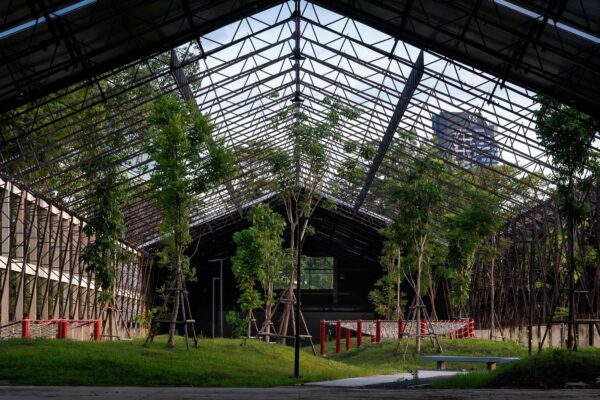
Royal Thai Army – 1st Development Division, Sarakadee Magazine, Mr.Srirath Somsawat